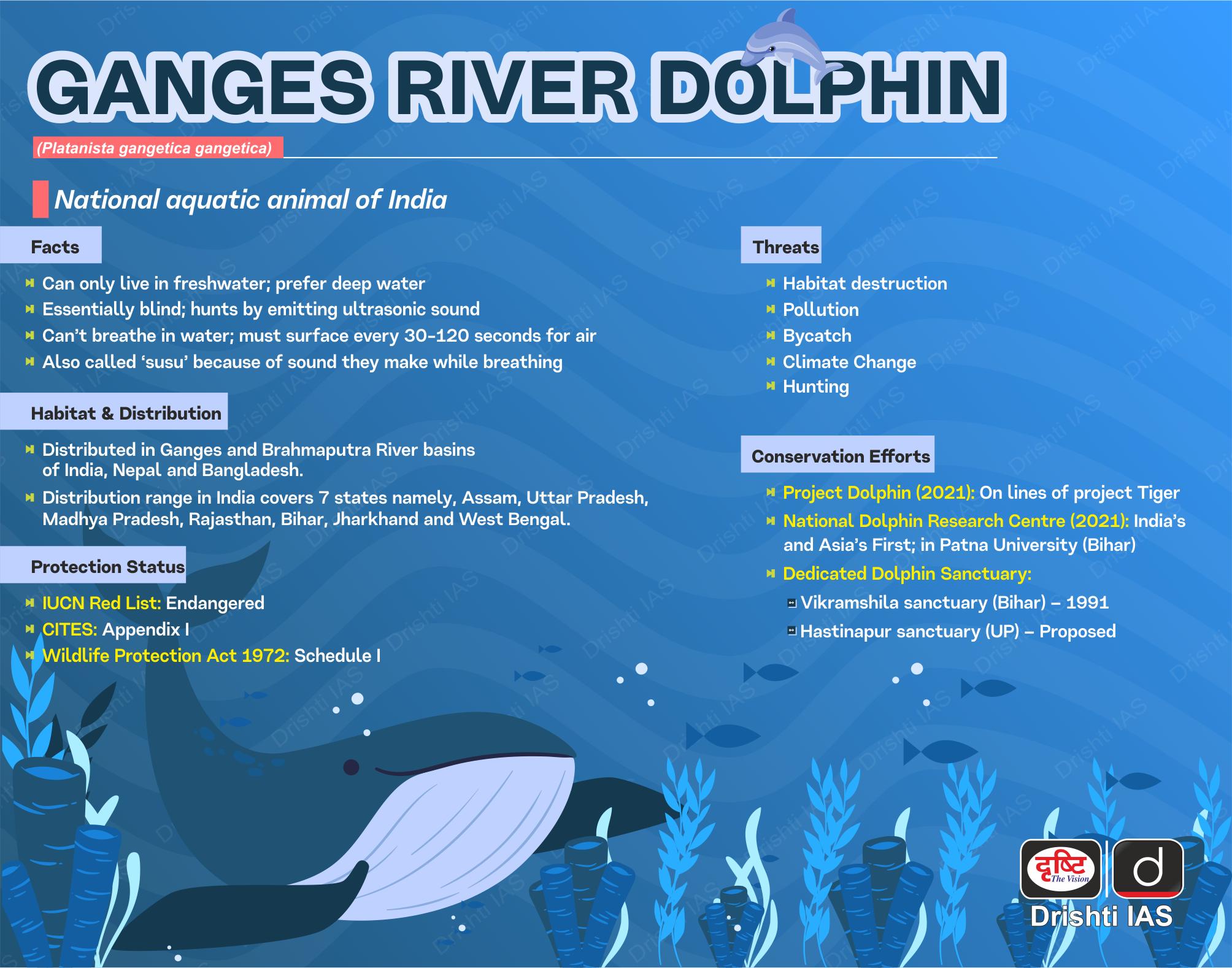Important Facts For Prelims
Ganges River Dolphin
- 10 Oct 2023
- 4 min read
Why in News?
A recent scientific publication titled "Rescuing Ganges river dolphins from irrigation canals in Uttar Pradesh, 2013-2020" has elucidated the comprehensive endeavors focused on the rescue and relocation of Gangetic river dolphins from precarious situations within the irrigation canals of the Ganga-Ghagra basin.
What are the Major Highlights of the Report?
- Dams and barrages have severely affected the habitat of the dolphins, forcing them to move into irrigation canals where they are at risk of injury or death.
- Over 70% of entrapments were reported either post-monsoon or during peak winter, while the other 30% of dolphins were rescued during peak summer when water levels fall and the minimum water flow is maintained.
- 19 Gangetic river dolphins were rescued from irrigation canals in the Ganga-Ghagra basin in Uttar Pradesh between 2013 and 2020.
What are the Major Points Related to Ganga River Dolphin?
- About:
- The Ganga River Dolphin (Platanista gangetica), also known as the “Tiger of the Ganges” was officially discovered in 1801.
- Habitat: Ganges river dolphins historically distributed in major river systems (Ganges-Brahmaputra-Meghna and Karnaphuli-Sangu) of India, Nepal and Bangladesh.
- According to the recent study in the Ganga River Basin, the species recorded from the main stream of Ganga River followed by the tributaries, Ghagra, Kosi, Gandak, Chambal, Rupnarayan, and Yamuna.
- Features:
- The Ganges river dolphin can only live in freshwater and is essentially blind. They hunt by emitting ultrasonic sounds, which bounces off of fish and other prey, enabling them to “see” an image in their mind.
- They are frequently found alone or in small groups, and generally a mother and calf travel together.
- Females are larger than males and give birth once every two to three years to only one calf.
- Being a mammal, the Ganges river dolphin cannot breathe in water and must surface every 30-120 seconds.
- Because of the sound it produces when breathing, the animal is popularly referred to as 'Susu'.
- Importance:
- They have significant importance because it is a reliable indicator of the health of the entire river ecosystem.
- The government of India declared it the National Aquatic Animal in 2009.
- It is also the State Aquatic Animal of Assam.
- They have significant importance because it is a reliable indicator of the health of the entire river ecosystem.
- Major Threats:
- Unintentional killing through entanglement in fishing gear.
- Poaching for dolphin oil, used as fish attractant and for medicinal purposes.
- Habitat destruction due to development projects (e.g. water extraction and the construction of barrages, high dams and embankments), pollution (industrial waste and pesticides, municipal sewage discharge and noise from vessel traffic).
- Protection Status:
- International Union for the Conservation of Nature (IUCN): Endangered
- Indian Wildlife (Protection) Act 1972 : Schedule I
- Convention on International Trade in Endangered Species (CITES) : Appendix I
- Convention on Migratory Species (CMS): Appendix 1
- Related Government Initiatives:
- Project Dolphin
- Vikramshila Ganges Dolphin Sanctuary has been established in Bihar.
- National Ganga River Dolphin Day (5th October)
UPSC Civil Services Examination, Previous Year Question:
Q. Which one of the following is the national aquatic animal of India? (2015)
(a) Saltwater crocodile
(b) Olive ridley turtle
(c) Gangetic dolphin
(d) Gharial
Ans: (c)







